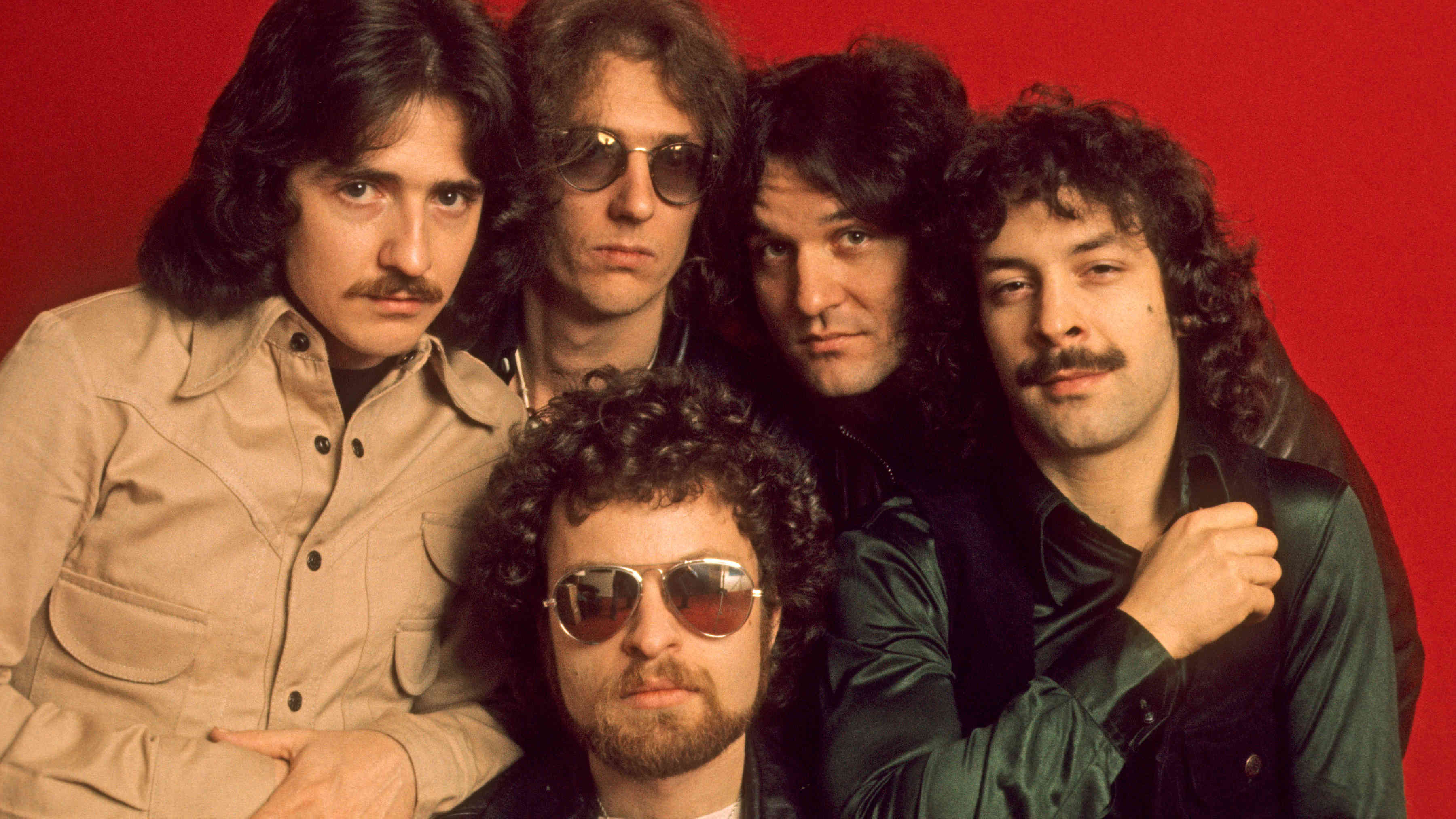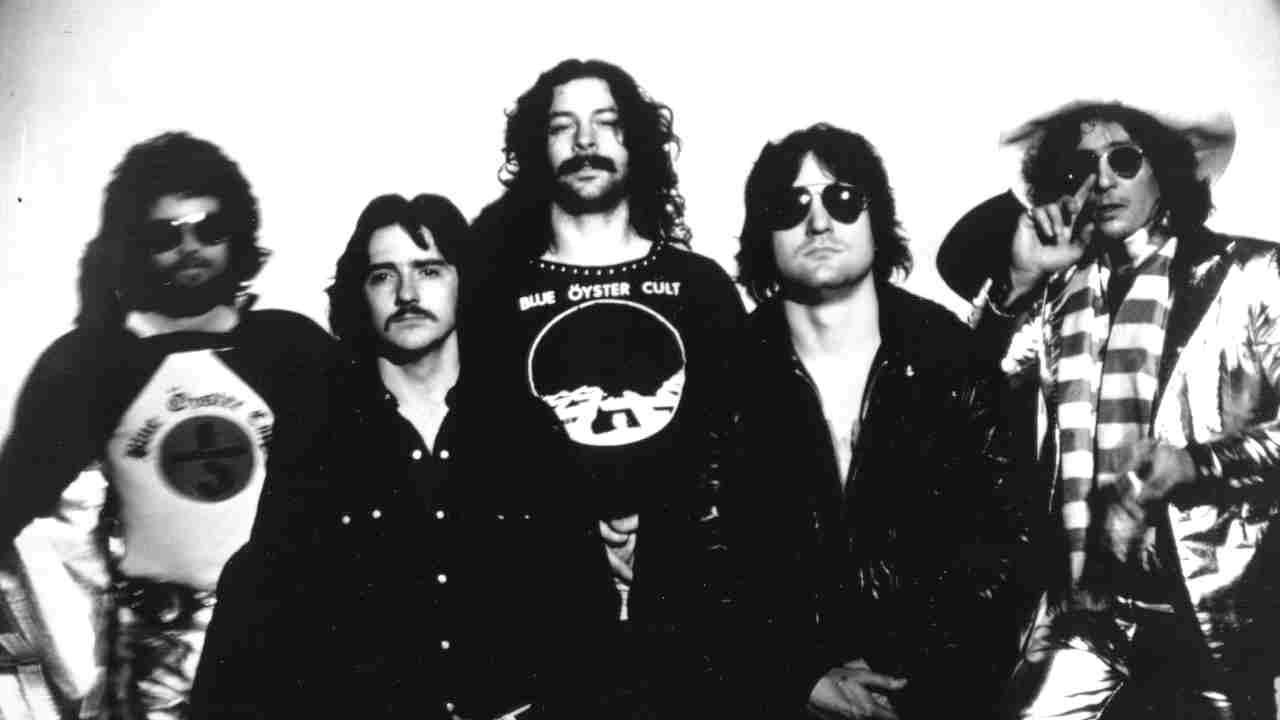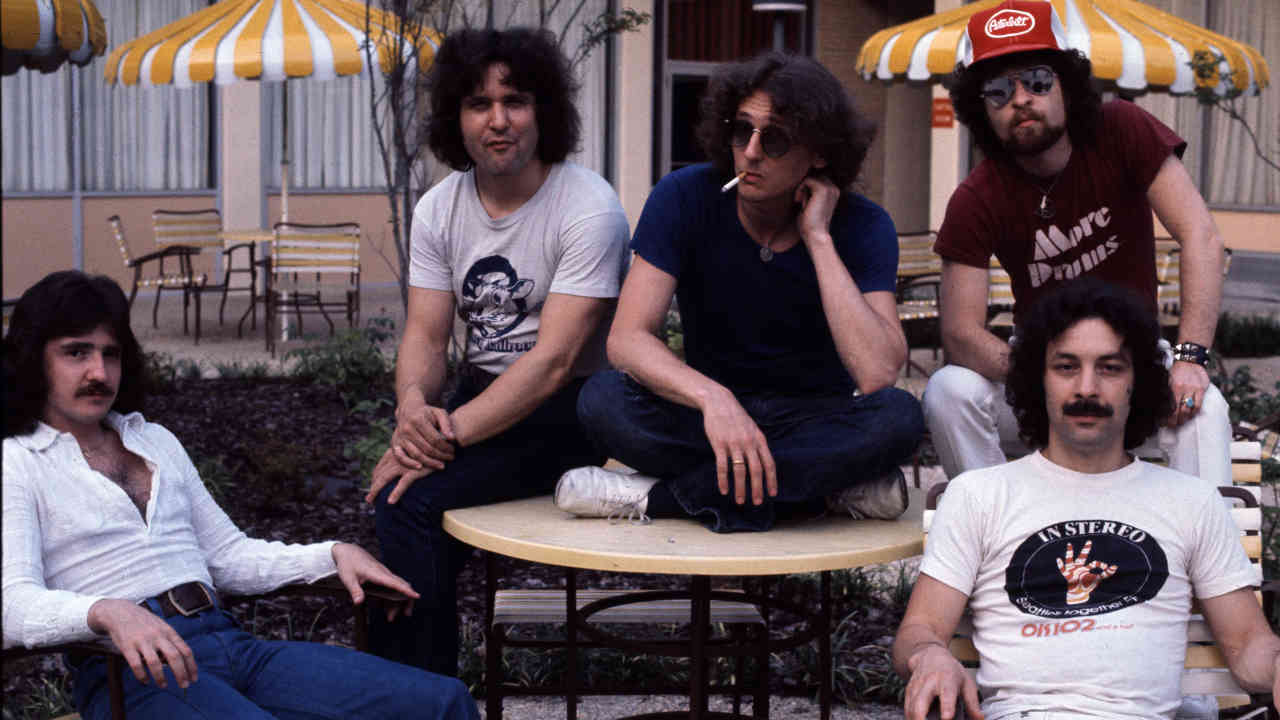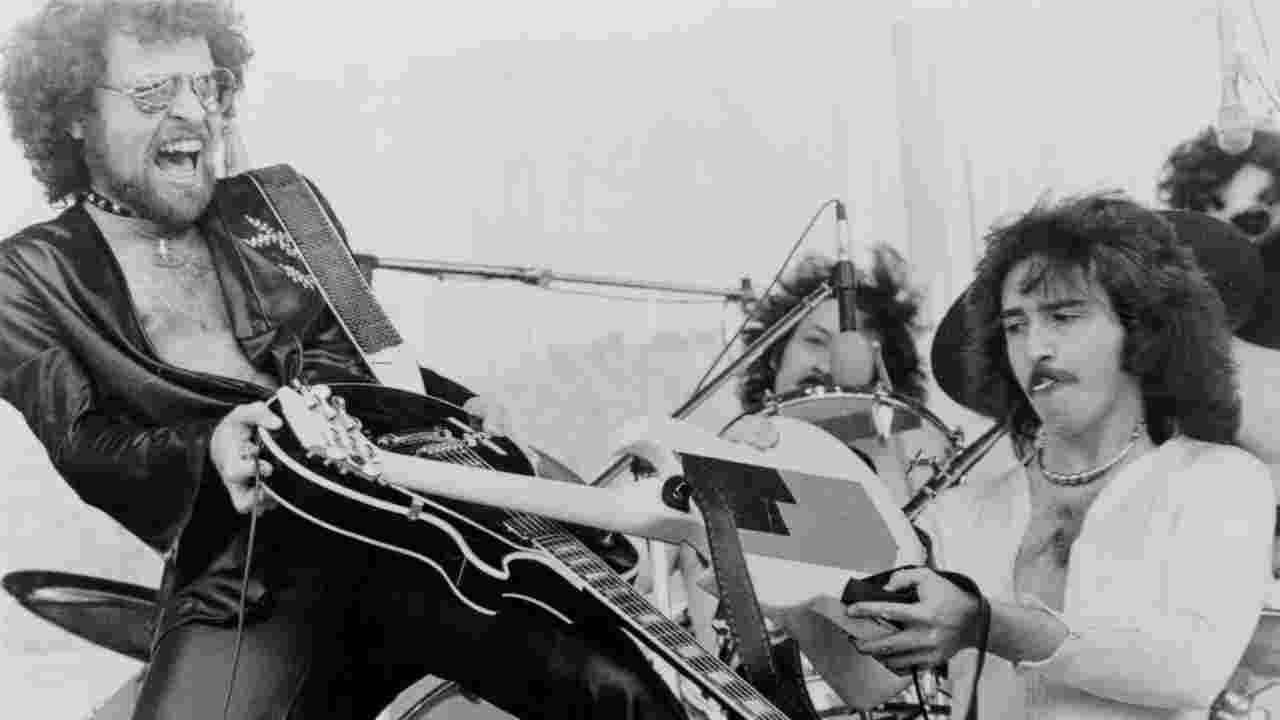
There’s always been a belief that Blue Öyster Cult were born to be one of the great bands of the 1970s, yet for some reason they didn’t get the recognition they deserved. Maybe that’s partly the band’s fault, as they never really courted fame.
Still, the group have left behind them a catalogue of albums and songs that place them firmly among the American élite. Whether you wish to see them as the US equivalent to Black Sabbath (as many have suggested over the years), a biker-friendly rock combo, or simply a band able to turn simple melodies into gothic symphonies (and also do the reverse), the fact remains that in their pomp Blue Öyster Cult were almost untouchable.
Yet, for all their current accolades and success, this is one band who did not find an immediate path to glory. In fact, it was only with their fourth studio album (and their fifth overall) that the five-piece finally gained serious sales momentum. That album was Agents Of Fortune.
Guitarist Donald ‘Buck Dharma’ Roeser is quick to acknowledge the unusual amounts of patience shown to the band by their record label at the time.
“If you look back at how our albums sold, it was a steady increase, rather than anything spectacular. So our first album [1972’s self-titled debut] sold about 100,000 when first released. The second album [1973’s Tyranny & Mutation] did a little better, and Secret Treaties [1974] increased our sales base further. But none of these was exactly the big seller Columbia Records were looking for.”
Roeser is convinced that had this pattern been followed by a young band in the current decade, they’d probably not have gotten past releasing their debut album.
“Columbia showed enormous commitment to us,” Roeser nods. “Despite the fact that we were displaying none of the sales potential others on the label were achieving, they never interfered. There was an unwritten belief we’d eventually come through, and it would be on our own terms.”

The band had begun in 1967, as Soft White Underbelly (a name they’ve since occasionally resurrected for secret shows) in Long Island. Over the next few years, they recorded two albums for the Elektra label, neither of which was released (there was also one single, What Is Quicksand?/Arthur Comics, put out under the name of Stalk Forrest Group), and underwent several name changes, before finally settling on Blue Öyster Cult in 1971. That idea came from a poem written in the 1960s by manager/producer/svengali Sandy Pearlman, which described an alien race secretly guiding earth’s history.
By this time, the classic line-up of the band was in place, numbering Roeser, Eric Bloom (lead vocals/keyboards/guitar), Allen Lanier (keyboards/rhythm guitar), Joe Bouchard (bass) and Albert Bouchard (drums). A deal with Columbia was secured, following a demo the group recorded with producer/jingle writer David Lucas, and so BÖC set out on their plan for world domination.
While those early albums might have failed to set the globe alight, the band’s music was building a strong following on the live circuit. And it was this passionate fan base that was to deliver the sort of sales figures few might have expected from a live album.
The release in February 1975 of concert record On Your Feet Or On Your Knees was to give Blue Öyster Cult the chart cachet they’d so long sought. For while their previous three studio records had all failed to break the Top 50 in America, this time they cut right through, making it to No.22 in the chart. Rather like Kiss with their autumn 1975 set Alive!, and Peter Frampton with 1976’s Comes Alive!, the Cult had proven their commercial mastery with a live release. Except that On Your Feet… actually pre-dates both of these iconic records, so you could say that it was BÖC who set the trend for live albums breaking rock acts into the big time.
“We were all certainly surprised that it did so well,” chuckles Roeser today . “In the end it sold over half-a-million copies. That was the moment when everyone sat up and realised we were to be taken seriously.”
But the sales climb the band enjoyed here did lead to its own pressures. Now they were expected to deliver the same kind of sales with their next studio record.
“It’s the way a label works,” says Roeser. “Suddenly we were looking like a big band, and Columbia wanted whatever we did next to reflect this. So there was some sort of pressure on us. However, it wasn’t that bad. We didn’t have the powers-that-be bearing down on us, insisting we did certain songs. They let us get on with the next album without interference. All they said was that we now had a level to reach, and to surpass.”
The live record had bought the band a little breathing space. Instead of being rushed back into the studio to record a fourth album, now they could take a little more time to get things together. And the evolution of technology had also brought about one enormous change to the way they worked.
“Suddenly, multi-track tape machines were everywhere, and they were also really affordable. So, all five of us got ourselves these machines, and that immediately changed the writing dynamic between all of us.”
In the past, the five members had collaborated on all songs. While some would play a bigger part than others in developing certain tracks, it was definitely a case of the band working together to produce their best work. Now, however, things had changed drastically.
“What these machines meant was that all of us could stay at home and work on songs – which is why, for the first time, there are no tracks on Agents Of Fortune written by pairings of members of the band. The good thing, though, was that we cut out so much wasted time. Before, we’d turn up to rehearsals and spend ages knocking ideas about. Now, someone could turn up with a virtually finished song, and while others might add a little bit here and there, what was initially presented was of a far higher standard than in the past.”
For their crucial fourth studio album, the band again worked with the production team of Sandy Pearlman and Murray Kruger, although they also added David Lucas this time around.
“Of the three of them, David was probably the one with the most musical knowledge, and his presence was invaluable to us,” remembers Roeser. “With Sandy and Murray we knew what we were getting. Sandy, in particular, had a reputation for pushing people in the studio as far as he could – and sometimes a little bit more.”
Roeser recalls that Blue Öyster Cult always rose to the challenge with Pearlman, looking to find that extra something to keep him happy, and also to ensure that the songs were given as much of a shot as possible. But sometimes the producers could go too far in the search for perfection.
“We’re talking about the days when everything was recorded on to tape, which was a far different situation to the one facing bands now, when it’s all digital,” says Roeser. “Back then, when you were doing take after take after take, you knew that there was only so much tape available. So eventually you reached a point when the only way you could record yet another take was to erase what’s already there and put something new over it.
“There was a fine balance to be struck between doing as many takes as Sandy wanted, and realising that that you’d gone past the point when you were gonna get the best one. So often we’d get the perfect take early on, but we’d only realise it some time later, after doing several more.”

For Agents Of Fortune, BÖC went into the Record Plant in New York, one of the most famous and active studios of the era. But their choice to work at this famed location in New York City did unintentionally cause one rather amusing situation, as Roeser explains.
“Columbia Records had a deal at the time which meant that every album recorded for the label had to have one of their in-house engineers present – this was a union agreement that couldn’t be broken under any circumstances. Now, when we decided to go into the Record Plant, we didn’t have any need at all for one of the label’s engineers to work on the project. However, the agreement they had meant that one of their engineers had to be at the studio the whole time. But, as there was nothing for him to do, he just sat outside and read a book. Seriously, that’s what happened. Yet, while it seems daft now to have such a waste of manpower, the label were OK about it, the union was happy and the engineer never complained as he was getting paid to sit and enjoy himself.
“It was the sort of thing that happened back then – money being thrown away, just so everyone could stick to what was really a crazy agreement between the record company and a union.”
Blue Öyster Cult, by contrast, worked with discipline in the studio for Agents Of Fortune, and it was something the band were proud of achieving.
“None of us lived in New York, so we commuted to the studio every day from Long Island, and then went back there each night. You might read about some bands who would spend so many hours in the studio that one or more of them would pass out under the desk. That was never something that happened to us at the Record Plant.
“Another thing we avoided was having a second engineer on standby, just in case the first one got burnt out. We kept to strict hours while recording, working between 10-12 hours every day, which meant we were able to keep fresh for far longer.”
While the band were all in the studio when the backing tracks were recorded, a process which took a week to 10 days, only one or two members would be present at a time as the overdubs were cut over a subsequent period of two weeks.
“You’d only go into the studio when you were needed,” says Roeser. “It was very rare for anyone to be in there unless they were required. Otherwise the chances were you’d get in the way.”
With an average of one song being mixed per day, in all the band spent about six weeks in the studio. While that might seem like no time at all by modern standards, this was still an era when bands used to record very quickly.
“We grew up at a time when it wasn’t unusual for artists to do whole albums in one or two days. But by the time we got in to do Agents Of Fortune, all of that was changing, with bands spending longer and longer on recording. But for us, it was always a case of taking all the time we needed, but never overstretching. You can spend too much time on an album, and it becomes counterproductive.”
With the cost of working at somewhere like the Record Plant being rather high, the band were determined not to waste any time. So the likes of Kiss and Aerosmith might have also been working at the same studio complex during this period, but there was little hanging out to be done.
“We were all aware of just how much it was costing, so to have just gone out and partied with the guys from Kiss and Aerosmith would have been daft. They felt the same way, so you did have all three bands in there, just keeping to themselves and not interacting much. You might get one or two members of those bands wandering in to see how we were doing, but there was never a thought about asking any of them to guest.
“To be honest,” Roeser adds, “there was sort of a competitive atmosphere in the studio between the three bands. It never got rough or nasty, but we were all focused on doing the best that we could, and really paid very little attention to what the others were doing.”
When the new BÖC album was finished, Columbia Records (who’d been kept at arm’s length throughout the recording process, and seemed happy to take a back seat) finally go to hear what they’d paid for. And their reaction was exceedingly positive.
“They really appeared to like what we’d done,” says Roeser, “and the attitude we got from the label was that they believed we’d come up with a big seller.”
This conviction deepened when they got a hit single straight out of the box with the immortal (Don’t Fear) The Reaper, which remains the most famous song the group ever recorded. The song has also led to considerable misinterpretation down the years, as Roeser (who wrote this song) is quick to point out.
“I still have people coming up, talking about how this song was all about death. The truth is that I wrote it about love. I’d been diagnosed with having a heart problem. It turned out to be a fairly benign condition, but at the time it did make me think about dying. That was where the spark for the song came from, but it quickly turned into something very different.”
In the lyric, Roeser ponders how love might transcend death, and how two people might be reunited on the other side, reaffirming their commitment to each other.
“People have compared this to the story of Romeo & Juliet, and there are similar elements to both. Overall, though, this is a song of hope rather than a song about the finality of death. It’s about wishful thinking.”
The song was a big hit in both America and the UK, reaching No.12 on its first release in the States and making it to No.16 over here. The track was unlike anything else the band had ever done, and for that reason alone there were fans who felt BÖC had ‘sold out’.
“That was never the case,” insists Roeser. “But it is different to the sort of thing that we did. Usually, BÖC were known for having an edge and an evil sound; none of that is present at all here. Maybe part of the reason was because I did the lead vocals, instead of Eric. But then, we were one of the few bands at the time where all the members could happily take the main role in singing – it set us apart from everyone. So the fact that I did the singing here wasn’t a problem for Eric. Since I’d written the song, it made sense.”
Roeser also confirms that the song was hardly adulterated between being written and being recorded for the album.
“If you listen to the demo version, which was included on the 2001 reissue, then it’s virtually the same as what went on to the album.”

One of the reasons that the song has remained so iconic down the years is that it was spoofed in a legendary skit from cult American TV comedy show Saturday Night Live in 2000, with Will Ferrell playing a fictional percussionist member of BÖC, repeatedly urged on to play ‘more cowbell’ during the session by the group’s producer (portrayed by Christopher Walken) . Roeser still chuckles at the memory of the sketch.
“I had no idea they’d done it. But this wasn’t the first time SNL had ripped it out of a song or a musician. I must have watched the sketch about 30 times now, and still laugh every time. It is just so hilarious, and to me it was an honour that they chose one of my songs to send up.”
The album was given its title by Murray Krugman, with the agents of fortune being another term for a deck of cards. It was released in May 1976, reaching No. 29 in America and No.26 in Britain – the first time that the band had charted over here with any album. It went on to sell over a million copies, and established the band as significant players. Roeser himself sees its success as not only a clear mandate for the songs featured, but also a vindication of a recording process that went remarkably smoothly.
“We had hardly any trouble in the studio. In fact the only song I can recall giving us any problems was Tenderloin, one of Allen Lanier’s tracks. We had a lot of difficulty getting this down properly. I think this was a reflection of the fact we didn’t spend enough time on it in the pre-production stage. But even with that song, we finally got what we wanted.”
Agents Of Fortune wasn’t just a commercial turning point for the band, but would also prove to be perhaps their most celebrated record. Only 1981’s Fire Of Unknown Origin would do better in America (it got to No.24), while in the UK 1980’s Cultösaurus Erectus would be their sole subsequent record to chart higher, making it to No.12.
“It’s hard for me to pick out the definitive BÖC record, because so many have got lots of fine moments. But I guess to most people Agents Of Fortune was our most outstanding release. Columbia were really happy with what it achieved, and while I think there’s an argument that the first three studio albums combined represent our finest body of work, when it comes to individual records, that is probably the one.”
The success of the album allowed Blue Öyster Cult to step up a level as a touring band, headlining arenas across America, and also invest in laser technology for their stage show, making their concerts cutting-edge entertainment.
“Having the space in venues meant we could now really stretch out,” says Roeser. “And getting the lasers was a very exciting moment for us. The one mistake we made was in buying the equipment outright. What we should really have done was lease it. But when you’re a band getting the first taste of real success you make such mistakes.”
Overall, though, Roeser is delighted with what the band achieved with Agents Of Forune. Not only did it finally give them the stature for which they’d been striving for so long, but it also confirmed Blue Öyster Cult as one of rock’s all-time great groups. And it gave them a large slice of the AOR market at a time when this was slowly evolving.
“There’s a lot of melody on the record, perhaps more than we’d ever had before,” says Roeser. “We never saw ourselves as being part of the AOR scene. But that is where the album belongs.”
Originally published in Classic Rock Presents AOR issue 2







